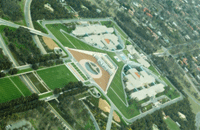'Green Roofs' for Green Homes
Energy could be saved by creating green roofs and walls covered with plant life such as grass, moss or creepers. Scientists have found green surfaces can reduce the need for air conditioning on hot days by causing local temperatures to drop.
Research was carried out by Eleftheria Alexandri and Phil Jones at the Welsh School of Architecture in the UK. They used computer models to find out how temperatures can vary when buildings are covered in greenery.
The models compared green plant-covered concrete to bare concrete in nine cities. The cities exposed surfaces to a whole range of weather conditions and included humid Mumbai, temperate London, and tropical Brasília.
They found green walls and roofs reduce local temperatures in the hottest months. The hotter the climate, the greater the cooling effect.
"In addition to the fact that they add a further insulation layer to the building, the green surfaces can decrease air conditioning demands inside the building," says Phil.
It's easy to cut out air conditioning when local temperatures can be reduced by as much as 11.3 degrees Celsius!
Surfaces covered in vegetation lower local temperatures in two ways. Green coverings normally absorb less heat than other building surfaces, and plants transpire giving off water which evaporates and has a cooling effect.
In winter the green surfaces can provide insulation by preventing heat from escaping, depending on the water content of the roof. This could keep homes warmer, reducing the need for heating too.
Green surfaces are already in use all over the world. In Germany, where the green roof was invented, it is thought that up to 10 per cent of roofs have been greened.
Although these roofs are successful in Europe, their greenery may not be suited to the harsh Australian climate and planning must go into selecting suitable plants. But this doesn't stop Australia from having green roofs – perhaps the best example is Parliament House in Canberra.
Green roofs have other environmental benefits too. For example the plants can capture carbon dioxide which contributes to climate change. And there's more - green surfaces can provide a habitat for animals, insects and plants that have few natural spaces to live in cities.
Although it sounds simple, don't run out and plant grass or shrubs on your own roof just yet. A green roof needs water proofing, a root repellent system, a filter cloth, and drainage system fitted by a green roof specialist to meet building regulations. Green roofs are also heavy and many roofs need to be changed to support the extra weight.





